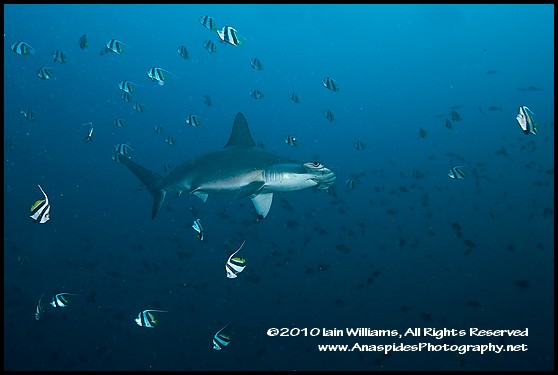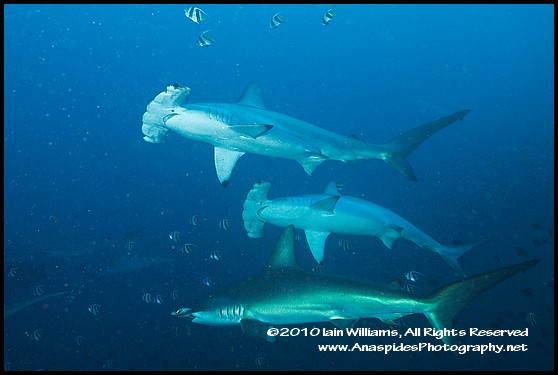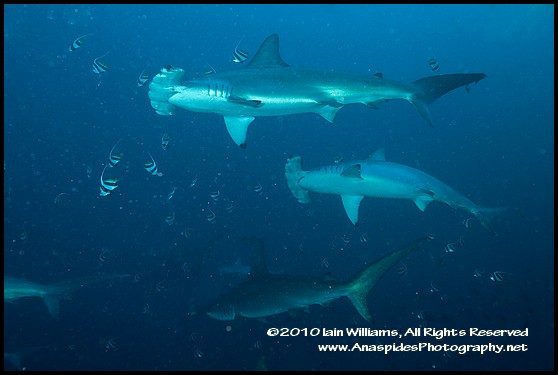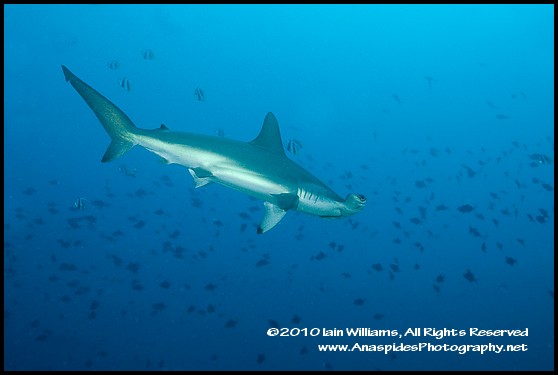Hammerhead Sharks, Indonesia
 Wednesday, December 22, 2010 at 10:30PM
Wednesday, December 22, 2010 at 10:30PM  I had be told that this area was prone at certain times of the year to schools of hammerhead sharks, however, didn’t expect to see them. I’ve dived with lone hammerheads on several occasions, but I have never encountered a large school. Sharks aren’t common to see, and when you do see them often they are fleeting glimpses that last less than a few seconds.
I had be told that this area was prone at certain times of the year to schools of hammerhead sharks, however, didn’t expect to see them. I’ve dived with lone hammerheads on several occasions, but I have never encountered a large school. Sharks aren’t common to see, and when you do see them often they are fleeting glimpses that last less than a few seconds.
LEFT: A Scalloped Hammerhead Shark surrounded by Banner Fish cruises past.
The water I was diving was along the edge of a tectonic plate and as such was very deep; a coral encrusted shelf sloped away into the abyss and the sea bottom was over a kilometre below. Unfortunately, on this day the weather was overcast and the water was not as clear as I would have liked. The current has picked up along the reef edge and entrained quite a bit of silt and sand in the water column. Levelling out at a tad over 30 meters (100 feet) I hovered above a sandy plateau that extended a short distance before dropping off to unimaginable depth.
 The Edge of the School
The Edge of the School
I then saw my first hammerhead in the distance. It was a large individual reaching roughly 4 meters (15 feet) in length. It kept its distance and disappeared as quickly as it had appeared. Making my way over the sandy plateau I began to descend further until reaching 47 meters (150 feet) in depth.
LEFT: Swimming into the school, several Scalloped hammerhead sharks patrol beside me.
It was then that I saw a mass of movement directly in front of me; I had reached the edge of a school of Scalloped Hammerhead sharks. Quickly counting, I calculated that 9 sharks were immediately within my vision, these sharks swam past me to be replaced by more sharks following. I swam into the school and all I could see was shark! Every few meters there was a shark, followed by another which was beside another – there were sharks everywhere – WOW. I noted that all the individuals were females and I wondered where the males were!
I knew I had to photograph quickly as the time allowed at 47 meters is minimal and I was already at the verge of entering decompression. Moving my strobes out from the housing, I attempted to position them in such as way as to minimise the back scatter, that I knew would occur from the suspending silt and sand. I fired a few frames and as the duel strobes (flashes) whined to recharge, I observed that the sharks became a little agitated; one individual dropped its pectoral fins and arched toward me like a fighter plane peeling away from the squadron. The shark came within arm’s reach before veering off to join its brethren. The reason for the behaviour is quite simple, and occurs with most active sharks when divers use electronic strobes. The recycling from the battery pack to the flash cell causes a high frequency whine which is picked up by the Ampullae of Lorenzini, the name for a shark’s super-sensory electrical device; this momentarily excites the shark.
 Fearful
Fearful
I wasn’t prepared for the fast approach and immediately felt apprehensive; suffering the effect of slight narcosis did not add to the situation. As my heart rate increased due to my sudden apprehension, two hammerheads swam in my direction to investigate; sharks are similar to dogs in that they can smell fear! In situations like this fear can feed on fear itself and spiral until one looses control of the situation.
Realizing this, I regained my composure, aimed and fired off another frame followed by another. I swam towards the school again and was annoyed that there was so much sediment in the water; I hoped the light from the flashes was not reflecting on the sediment, but there was little time to look at the camera LCD screen to check – things were happening very fast as hammerheads glided in from the main school to investigate me and my whining strobes!
I was over 45 meters in depth and well into a 15 minutes decompression obligation (the time I would have to spend at a shallower depth to allow nitrogen off gassing; failure to complete this time may lead to decompression sickness). I was trying to swim somewhat beneath the sharks so I could shoot with a slight upwards angle; a photographic composition like this would show the power, size and presence that such an animal deserved.
I Wanted the Perfect Shot
I wanted to get the perfect shot. I wanted the right composition and exposure. I wanted three sharks in the correct position. But, there wasn’t the time. To continue would be foolhardy. I then realized that my time was up. I had to depart immediately for a shallower depth or suffer the consequences of either low air or too greater decompression obligation. It’s at times like this that you must understand that the photograph is second to your own safety.
I had reached the threshold and I was pleased that I had listened to reason and not continued. With slight regret at not been able to take the perfect photograph, I slowly ascended to my decompression depth. However, I was elated at being able to swim with of a school of hammerheads at close quarters; the experience transcends the photographs!
BELOW: A Scalloped Hammerhead shark swims above me before changing direction abruptly to make another pass. Encounters with large predatory animals are uncommon and this experience will remain with me for sometime. Most of the images on this dive were shot at 35mm at ISO400, 1/125th @f8.
 Natural History
Natural History
Scalloped Hammerhead Sharks (Sphyrna lewini) are probably the most commonly found species of hammerheads located in coastal regions, appearing in very shallow waters such as estuaries and inlets. Their distribution in the water reaches from the surface down to a depth of approx. 275 m. The young, however, remain mostly in shallow waters along the shore to avoid the danger of falling into the mouths of predators. At certain times of the year and places, and during certain phases of their lives, scalloped hammerheads form very large schools, sometimes counting hundreds of individuals, but they also swim the oceans alone. Some populations remain stationary, others clearly wander, migrating in the direction of the poles in summer. Some sexually-related migrations have also been observed, e.g. females who undertake migrations during particular periods of their sexual development.
As already mentioned, this shark species tends to form huge schools whose function is presumed to be manifold and may, among other things, concern feeding habits and reproduction. Although many studies also consider this behaviour to be a group protective function, this is somewhat questionable since the animals have practically no natural enemies after reaching full maturity. Groups of scalloped hammerheads prefer staying in regions which have pinnacles or sea mounts which reach from great depths practically to the water's surface. Latest research also shows that these sharks can make use of the earth's magnetic field during their migrations.
Why No Location Mentioned
You may wonder why I have not mentioned the location. The reason is that all sharks are in danger from being over harvested by fisherman. Schools of sharks such as the school I had encountered are in demand by the fishing fleet, not for meat, but for their fins. The sharks are caught on long lines and pulled to the side of the boat, and a very sharp knife used to slice off their fins. The doomed creature is then pushed away from the boat and left to die an agonising death. The fins are used in shark fin soup which is a Chinese delicacy.


